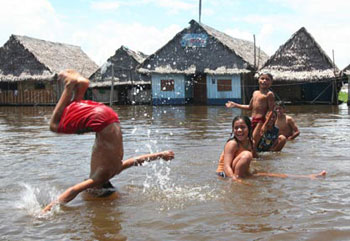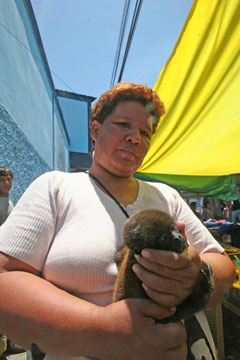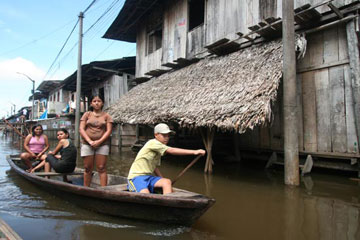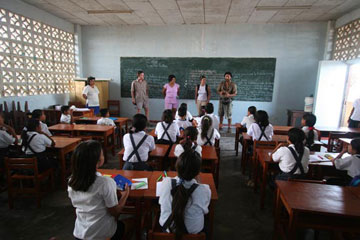Special to mongabay.com: Wilderness Classroom: Expedition 2006 The following is an update from The Wilderness Classroom’s expedition to the Peruvian rainforest. You can follow their adventures at wildernessclassroom.com |
Exploring the Flooded Streets of Iquitos, Peru
The Wilderness Classroom Organization
April 9, 2006
Update 6: Exploring the Flooded Streets of Iquitos – Dave
In Monday’s Daily Dilemma, we asked students to help us figure out how we should get around while we are in Iquitos. Students responded with a variety of good answers. The majority of you thought that we should use canoes to explore and do our shopping in the Belen Market.
Following your advice, we hired a strong young man to paddle us around the flooded streets of Belen. Jose is like a taxi driver, but instead of driving a car he drives a canoe. Belen is on the edge of the large city of Iquitos. Belen is unique because much of the city is covered in water for most of the year. From January to May the streets, soccer fields, and gardens are underwater. Many of the houses are built on rafts that float up and down as the river rises and falls. Other houses are built on stilts so that the water does not cover the house when the water rises.
The floating city was full of life: people paddling canoes, children swimming and laughing, people going about their daily lives in houses floating on the Amazon River.
I have never experienced such an interesting city, and it proved to me the people can adapt to and survive in the flooded forest.
 It was very hot yesterday. There were children laughing and playing in the water throughout the flooded city. |
Wednesday’s Daily Dilemma sparked some very strong reactions from students. Students were asked if they thought selling wild, rainforest-dwelling animals as pets was okay. All of the responses were in favor of keeping the animals wild.
It was such a heated debate that we decided to write more about the situation in today’s Animals of the Amazon. Great work, Student Explorers! You’ve shown to us that you care about the rainforest habitat and its inhabitants.
Update 6: The Wild Woolly – Anna
At the Belen Market we ran into several animals from the rainforest being held in captivity. One of those animals was a baby woolly monkey. The owner told us that her brother had recently hunted the mother woolly monkey for food for their family, and that left the baby with no where to go. The baby would be killed in the wild without the protection of its mother. The woman was trying to sell the baby monkey as a pet. When I held the baby, it immediately wrapped its prehensile tail around my arm. The word prehensile means that it is used like a hand: to grip things. Since it can be used much like an arm or leg, the tail helps the monkey swing from tree to tree in the wild.
Woolly monkeys, like most monkeys, are very loud. Until it got comfortable in my arms, the monkey was screaming much like a baby. In the wild, the woollys move around in large noisy troops, reminding the entire rainforest that they are present with their barks and whoops. Most adult woolly monkeys grow to about one and a half feet long and have a tail that is usually longer than their body. They can weigh over 22 pounds. Woolly monkeys feed on fruits, seeds, leaves, and the occasional insect.
 A woman selling a baby woolly monkey in the Belen Market. She wanted about $15 for the little primate. |
Woolly monkeys are commonly hunted for their meat, which locals have claimed is the best tasting monkey meat in the rainforest. Because females only give birth to a baby every other year, and because the monkey is commonly hunted, the woolly monkey is at risk of becoming endangered.
The baby woolly monkey that we saw seemed quite bothered by its new caged home. Not only had it lost its mother, but it lost its home in the rainforest. Yet at the same time, its mother was a food source for a hungry family living in the Amazon. As we travel through the rainforest, we might come across several situations like this. Regardless, the woolly monkey is definitely a beautiful and intelligent creature, deserving of a good life. Hopefully we will see more woollys in the wild as we continue our journey through the flooded forest.
Update 6: Floating to School – Anna
During our canoe trip at the Belen Market, we stopped by a school to see about a day in the life of a Peruvian student. The school is built on stilts, and since the town is covered in thirty feet of water, the children canoe to school every day. They pull their boats up under the school and climb up the ladder and into the classroom.
The school that we visited has 300 registered students, but in the rainy season only about 150 attend. Most of the families only have one canoe, and if the children take it to school, the rest of the family doesn’t have a way to get off of their floating house. Therefore, during the rainy season many kids don’t attend school.
There were about 20 school children in each class, and the classes were full of students of all ages. One classroom had students between the ages of 11 and 15. That’s quite a range!
The students told us that they like school and they like living in Iquitos, but the weather is too hot. I definitely agree with that!
After school the students canoe home and help take care of their siblings, help prepare dinner, do their homework, and most importantly, they go swimming! The only relief from the blazing hot sun and 100% humidity is a dip in the river: right off of the house! As we paddled around the neighborhood we saw many children swimming around and playing games in the water.
 We passed dozens of canoes shuttling people, food, and cargo around the city.  We parked our canoe on the steps of the school, and went inside to visit with the students. |
After school, to make money for the family, some of the students paddle their canoes around the neighborhood and act as a taxi service for people who don’t have boats. A few of the girls said that they help their mothers weave baskets and purses to sell at the daily market. Whatever the after-school activity is, they almost all require canoes to get from place to place.
It was quite fun spending time getting to know the kids in Iquitos. They live very different lives than we do in the United States. From a very young age, the kids learn how to canoe. By the time they are five or six, they are masters at the sport and can successfully canoe to school each day. How is that for a different way of living?
Update 6: To Give Or Not To Give – Dave
In our first week in Peru, we have had all kinds of interesting encounters with people of the region. Just like in the United States, some people are poor and hungry and are on the streets begging for money. Nearly everywhere we have gone, people have approached us, asking for money. Some of them even follow us around the markets and streets and continue to beg.
What should we do when these people approach us and ask for money? Unfortunately, we don’t have enough money to give to everyone that asks! And, just like in the United States, how do we know that the money is going towards food for their bellies instead of towards things that aren’t good for them?
Getting around “Venice on the Amazon”
We had great fun cruising the streets in mottocarros and floating the canals on a canoe taxi. The people of Iquitos are very adaptable, brave and strong. Can you imagine life in a floating house?
Track the adventurers at wildernessclassroom.com